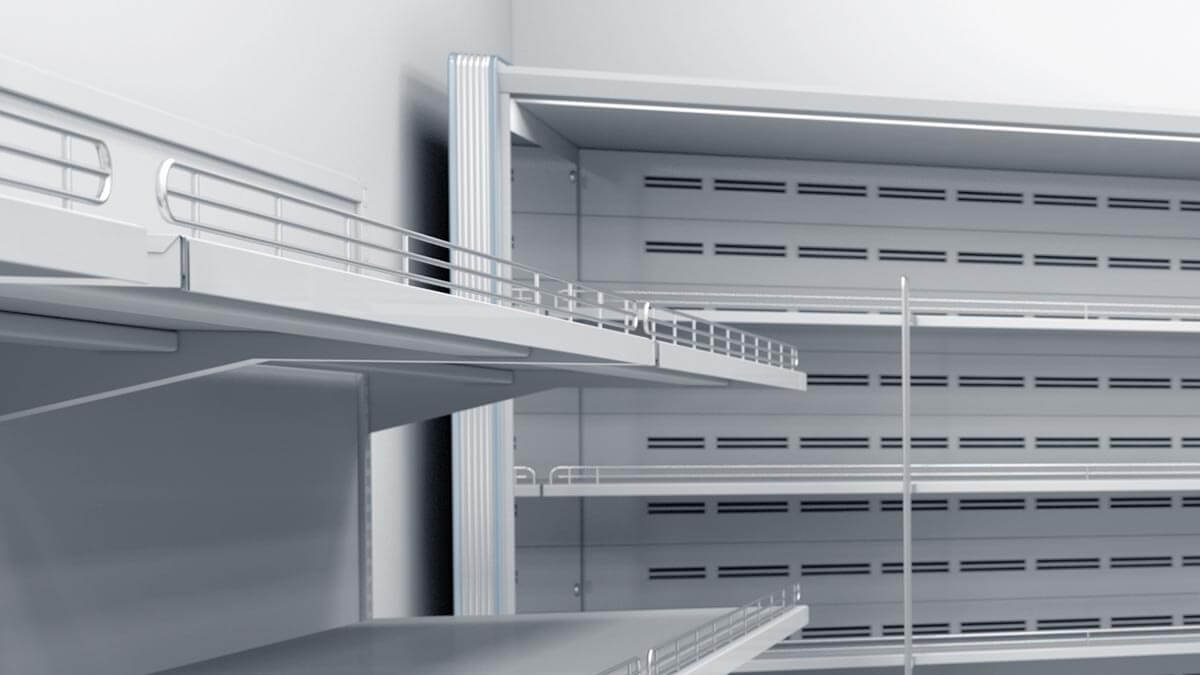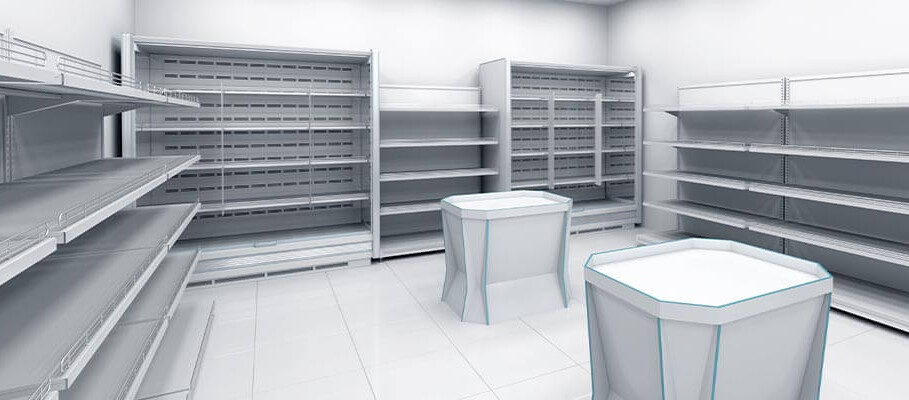Table of Contents
- The Foundation of Supermarket Layout: Strategic Shelving
- Corner Shelving Units: Turning Awkward Spaces into Profit Centers
- Material Matters: Choosing Between Glass Shelves, Wooden Shelves, and Metal Shelving
- Alcove Shelving: Making the Most of Recessed Spaces
- Twin Slot Shelving: Versatility and Adaptability
- Metal Shelving Unit Considerations: Durability and Load Capacity
- Creating Ambiance with Rustic Shelves and Oak Shelves
- Narrow Shelving Unit Solutions for Tight Spots
- The Art of Display: Showcasing Products Effectively
- Installation and Maintenance: Ensuring Safety and Longevity
- Pro Tip: Strategic Shelving Variety
- Conclusion: Shelving as a Strategic Investment
1. The Foundation of Supermarket Layout: Strategic Shelving
Before diving into specific types of shelving, it's essential to understand the broader role shelving plays in supermarket design. Effective shelving isn't just about storing products; it's about creating a shopping environment that is:
- Organized: Customers should be able to easily find what they're looking for.
- Appealing: Products should be displayed in a way that encourages purchase.
- Efficient: The layout should maximize space utilization and minimize wasted areas.
- Safe: Shelving should be stable and secure, preventing accidents.
These factors directly impact the customer experience, influencing their perception of the store, their purchasing decisions, and their likelihood of returning.
2. Corner Shelving Units: Turning Awkward Spaces into Profit Centers
Corner shelves and corner shelving units are often overlooked, but they represent a significant opportunity to maximize space. Corners are inherently awkward spaces in any room, and supermarkets are no exception. Traditional shelving often leaves these areas underutilized. However, purpose-built corner shelving units can transform these dead zones into valuable retail real estate.
Pros:
- Maximizes use of otherwise wasted space.
- Creates a seamless, continuous flow of shelving.
- Can be used to highlight specific product categories.
- Improves overall store aesthetics.
Cons:
- May require custom fitting depending on the corner angle.
- Can be slightly more expensive than standard shelving units.
- Accessibility might be slightly reduced in very deep corners.

3. Material Matters: Choosing Between Glass Shelves, Wooden Shelves, and Metal Shelving
The material of your shelving significantly impacts both aesthetics and functionality. Each material has its own strengths and weaknesses:
- Glass Shelves: Often used for premium products, glass shelves create a sense of elegance and allow for maximum visibility. They are ideal for showcasing high-end items like cosmetics, jewelry, or electronics. They are easy to clean, but may not be suitable for heavy items.
- Wooden Shelves: Wooden shelves, particularly oak shelves, offer a warmer, more natural feel. They can be used to create a rustic or upscale ambiance, depending on the finish. They are sturdy and versatile, but may require more maintenance than metal or glass.
- Metal Shelving: Metal shelving and metal shelving units are the workhorses of the supermarket world. They are durable, strong, and capable of holding heavy loads. They are ideal for bulk products, canned goods, and other heavy items. While not as aesthetically pleasing as glass or wood, they are highly practical and cost-effective.
For an external resource on shelving materials and their properties, you can refer to the Wikipedia page on Shelving. This provides a broad overview of different shelving types and materials.
4. Alcove Shelving: Making the Most of Recessed Spaces
Similar to corners, alcoves – those recessed areas in walls – often present a challenge for traditional shelving. Standard rectangular shelving units simply don't fit efficiently, leaving wasted space and creating an awkward, unfinished look. Alcove shelving, however, is specifically designed to address this issue. These units are built to fit snugly into recessed spaces, providing a seamless and integrated storage solution.
The beauty of alcove shelving lies in its customization. Unlike off-the-shelf units, alcove shelving can be tailored to the exact dimensions of the recess, maximizing every inch of available space. This is particularly valuable in supermarkets where every square foot contributes to potential sales. Think of those often-unused spaces between structural columns, or the small recesses near doorways – these areas, often overlooked, can be transformed into valuable display or storage areas.
Beyond space maximization, alcove shelving can also enhance the overall aesthetics of the store. By filling in these recessed areas, you create a cleaner, more unified look, eliminating visual clutter and drawing attention to the products on display. Furthermore, alcove shelving can be designed to complement the overall store design, using materials and finishes that match the existing decor. For instance, you could use wooden shelves in a rustic-themed section or glass shelves to showcase premium products in a more upscale area.
5. Twin Slot Shelving: Versatility and Adaptability
In the dynamic world of supermarket retail, flexibility is key. Product displays need to change frequently to accommodate new items, seasonal promotions, and evolving consumer trends. Twin slot shelving offers a highly versatile solution that allows for quick and easy adjustments, making it a popular choice for many supermarkets.
The twin slot shelving system is characterized by its vertical uprights, which feature pairs of slots running along their length. These slots are designed to accept brackets, which then support the shelves. This modular design allows for effortless adjustment of shelf heights – simply remove the brackets, reposition them in the desired slots, and reinsert the shelves. No tools are required, and the entire process can be completed in minutes.
Pros:
- Highly adaptable to changing needs: Easily adjust shelf heights to accommodate products of different sizes.
- Easy to install and adjust: No specialized tools or expertise required.
- Strong and durable: Capable of supporting significant weight, making it suitable for a wide range of supermarket products.
- Cost-effective: A relatively inexpensive shelving solution compared to custom-built options. The modularity also means you can easily add or remove components as needed, reducing waste.
Cons:
- May not be as aesthetically pleasing as other options: The visible slots can detract from the overall look, particularly in high-end or boutique-style supermarkets.
- The slots can be visible, which some may find unattractive: While functional, the industrial aesthetic may not be suitable for all store environments.
The adaptability of twin slot shelving extends beyond simple height adjustments. You can also easily add or remove shelves, change the spacing between them, and even incorporate accessories like hanging rails or baskets. This level of customization allows you to create displays that are perfectly tailored to your specific needs, maximizing both space utilization and product visibility.
6. Metal Shelving Unit Considerations: Durability and Load Capacity
When choosing metal shelving units for a supermarket environment, durability and load capacity are paramount. Supermarkets, unlike many other retail settings, often stock heavy and bulky items, from cases of canned goods to large bags of pet food. The shelving must be able to withstand these significant weights without bending, warping, or, worst-case scenario, collapsing.
The key to ensuring sufficient durability lies in the quality of the materials and the construction of the unit. Look for metal shelving units made from high-gauge steel, which provides superior strength and resistance to deformation. Reinforced construction, such as corner bracing and welded joints, further enhances the unit's stability and load-bearing capacity.
It's also important to pay close attention to the manufacturer's stated load capacity for each shelf and for the entire unit. These specifications should be clearly indicated and should be taken seriously. Overloading shelves is a serious safety hazard, posing a risk to both employees and customers. It's always better to err on the side of caution and choose shelving with a higher load capacity than you anticipate needing.
Beyond weight capacity, consider the finish of the metal shelving unit. A powder-coated finish is preferable, as it provides excellent resistance to scratches, chipping, and rust, ensuring the shelving remains in good condition even in a high-traffic environment. Regular cleaning is also essential to maintain the appearance and longevity of metal shelving.
Request a consultation to our team and discover how to effectively promote your products on our platform.

7. Creating Ambiance with Rustic Shelves and Oak Shelves
While functionality is crucial, the aesthetic appeal of your supermarket shelving also plays a significant role in shaping the customer experience. For supermarkets aiming to create a more upscale, natural, or inviting atmosphere, rustic shelves and oak shelves offer excellent alternatives to standard metal or glass options. These materials introduce warmth, texture, and a sense of craftsmanship that can elevate the overall store environment.
- Rustic Shelves: Often crafted from reclaimed wood, rustic shelves possess a unique, weathered appearance that adds instant character and charm. Each piece of reclaimed wood tells a story, with its knots, grain patterns, and imperfections contributing to its distinctive beauty. Rustic shelves are particularly well-suited for stores that want to convey a sense of authenticity, sustainability, or a connection to nature. They can be used to create a farmhouse-style aesthetic, a cozy and inviting atmosphere, or a more industrial-chic vibe, depending on the specific wood and finish.
- Oak Shelves: are renowned for their strength, durability, and timeless appeal. Oak has a warm, golden hue and a beautiful grain pattern that adds a touch of classic elegance to any space. Oak shelves can be used to create a sense of sophistication and quality, making them ideal for showcasing premium products or creating a more upscale feel in specific departments. The natural durability of oak also makes it a practical choice for a high-traffic supermarket environment.
8. Narrow Shelving Unit Solutions for Tight Spots
In many supermarkets, particularly in older buildings or densely populated urban areas, space is at a premium. Every inch counts, and maximizing the use of available space is a constant challenge. Narrow shelving units are specifically designed to address this issue, offering a practical solution for those tight spots where standard shelving simply won't fit.
These units are typically much slimmer in depth than traditional shelving, allowing them to be placed in areas such as:
- Between columns or pillars: Often, the space between structural supports is left unused. Narrow shelving units can transform these areas into valuable display space.
- At the ends of aisles: These units can create "endcap" displays, capturing customer attention and promoting impulse purchases.
- Along narrow walls: Where a full-depth shelving unit would protrude too far, a narrow shelving unit can provide storage without obstructing traffic flow.
- In small, awkward corners: Similar to corner shelving units, narrow units can be used to make the most of otherwise unusable space.
While narrow shelving units may not offer the same storage capacity as their wider counterparts, they can be surprisingly effective at increasing overall display space. They are particularly well-suited for smaller items, impulse buys, or products that you want to highlight in a specific location.
9. The Art of Display: Showcasing Products Effectively
Choosing the right shelving is only half the battle. How you arrange products on the shelves is equally important. Consider the following:
- Eye-Level Placement: Premium products and high-margin items should be placed at eye level, where they are most likely to be seen.
- Grouping Similar Products: Grouping similar items together makes it easier for customers to find what they need.
- Creating Visual Interest: Use a variety of shelf heights and arrangements to create a visually appealing display.
- Lighting: Proper lighting can highlight products and make them more attractive.
10. Installation and Maintenance: Ensuring Safety and Longevity
Proper installation and regular maintenance are crucial for ensuring the safety and longevity of your shelving.
- Installation: Shelving should be installed by qualified professionals to ensure it is stable and secure. Follow the manufacturer's instructions carefully.
- Maintenance: Regularly inspect shelving for signs of damage, such as loose bolts or bent supports. Clean shelves regularly to prevent dust and dirt buildup.
11. Pro Tip: Strategic Shelving Variety
Don't rely on just one type of shelving! A mix of materials and styles can dramatically improve your supermarket's layout and customer experience. Here's how:
- Visual Zones: Use different shelving to define product areas (e.g., glass shelves for premium items, wooden shelves for organic sections).
- Product Highlighting: Draw attention with specific materials (e.g., glass shelves for new products, rustic shelves for artisan goods).
- Space Maximization: Combine standard shelving with specialized units (corner shelving units, narrow shelving units) to utilize every area.
- Category-Specific Shelving: Match the material to the product (e.g., metal shelving for heavy items, twin slot shelving for frequently changing stock, Alcove Shelving for promotions.).
- B2B Testing: Use variety as an opportunity to A/B test. Track sales data for products on different shelving types to optimize your layout and product placement for your customers.
- Engaging Experience: A mix of shelving creates a more dynamic and interesting shopping environment, encouraging exploration.
By strategically combining shelving, you create a functional, visually appealing supermarket that boosts sales. Think about your store's design and how shelving can contribute to your brand and customer experience.
Get tailored quotes from suppliers that match your specific requirements. Start now by using our "Request for Quotes" page.

12. Conclusion: Shelving as a Strategic Investment
Effective shelving is more than just a storage solution; it's a strategic investment that can significantly impact a supermarket's profitability. By carefully considering factors such as space utilization, product display, and material choices, B2B professionals can create a shopping environment that is both efficient and appealing.
The right shelving solutions can help maximize sales, improve customer satisfaction, and ultimately contribute to the success of the business. And with that in mind, how might other retail sectors, such as electronics or apparel, adapt these shelving strategies to their specific needs?
For more information on supermarkets and the food industry, read these insightful articles:
- Glass Food Storage Containers for supermarkets
- Edible Food Packaging: A Sustainable Future?
- Fermented Foods: Benefits, Trends & Sustainability
- Stainless Steel in Food Processing: Highest Hygiene
- Gluten-Free Sweets: A Growing Market for B2B Bakeries
- Advancing Market Potential with Plant-Based Food Innovations
- Foodceuticals: The Future of Food & Health
- Vegan Sweets: A Growing Market for Bakeries
Find Shelving Products for your Project!
FORM CREATIONS offers comprehensive, custom design, production, and delivery of POSM materials across Europe, including a wide range of displays and stands made from various materials using diverse manufacturing processes, emphasizing modern design, functionality, competitive pricing, and quick turnaround.
METALCOOP specializes in designing, constructing, and installing high-quality metal shelving and offers integrated warehouse logistics solutions, including WMS software, alongside a wide range of complementary products.
HORGES GMBH LAGERTECHNIK is a certified manufacturer of high-quality, affordable steel shelving solutions, offering a wide range of customizable options for various industries and storage needs, with fast delivery and comprehensive warehouse planning services.
Gondella, a Belgian company, manufactures a complete, customizable shelving system, producing all metal components in-house and outsourcing only metal baskets, to deliver finished, epoxy-coated products in customer-specified colors.
RACK CONCEPT is a Belgian company with over 20 years of experience specializing in new and used shelving systems and warehouse equipment, serving Belgium, France, Luxembourg, and the Netherlands.
D&R Racking, based in Birmingham and established in 1984, supplies and installs a wide range of new and used storage solutions across the UK, including pallet racking, mezzanine floors, and shelving, with in-house installation teams and a warehouse clearance service.

